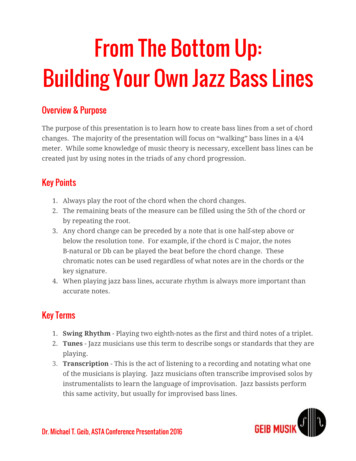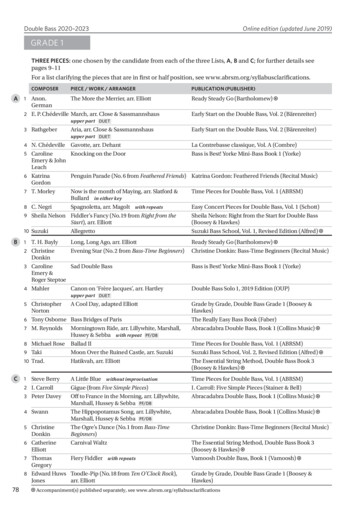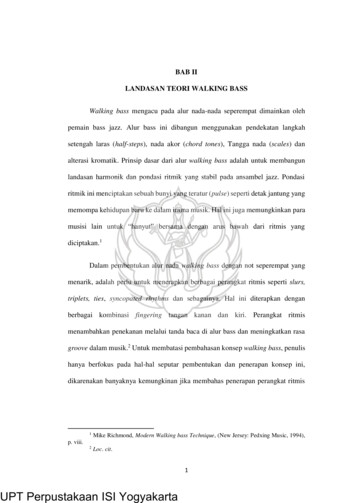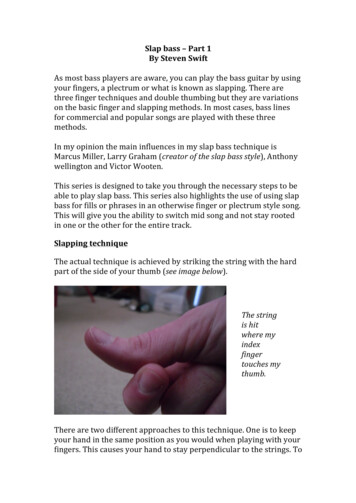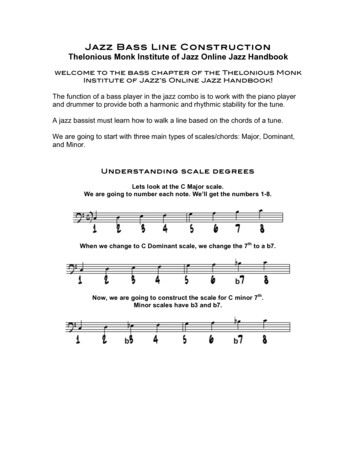
Transcription
Jazz Bass Line Con st ructionThelonious Monk Institute of Jazz Online Jazz Handbookwelcome to the bass chapter of the Thelonious MonkInstitute of Jazz’s Online Jazz Handbook!The function of a bass player in the jazz combo is to work with the piano playerand drummer to provide both a harmonic and rhythmic stability for the tune.A jazz bassist must learn how to walk a line based on the chords of a tune.We are going to start with three main types of scales/chords: Major, Dominant,and Minor.U nd er sta nd i ng sca le de g re esLets look at the C Major scale.We are going to number each note. We’ll get the numbers 1-8.When we change to C Dominant scale, we change the 7th to a b7.Now, we are going to construct the scale for C minor 7th.Minor scales have b3 and b7.
Next, we are going to look at chord tones. Chord tones are based on scaledegrees. We are going to look at the chord tones 1, 3, 5 and 7.Scale TypeMajorDominantMinorChord tones13571 3 5 b71 b3 5 b7Remember: To make a note flat, lower it ½ step, or ONE FRET.
BASS LINES PART ONEFor all of these exercises, we are going to use the cycle of 4ths. The cycle of5ths is just an organized way to travel through the keys so you hit every one.We are going to go move around the cycle counter clockwise.SERIES 1: Major ChordsStep 1: First, just play roots around the cycle. Play four quarter notes on eachchord.Step 2: Play ROOTS and 5ths around the cycle, two beats eachStep 3: Play the root pattern 1231 around the cycle
Step 4: Play the root pattern 1235 around the cycleStep 5: Play the root pattern 1357 around the cycleStep 6: Play the root pattern 1353 around the cycleNow you are ready to combine these patterns. Switch between a few patterns ata time. Let’s try alternating between 1235 and 1353 every chord:Now lets alternate between 1231 and 1357. That will look like this:
Mix and MatchWe presented you with 5 patterns to use. It’s your turn to improvise with thesepatterns. Play through the cycle over and over, trying different things each time.Whenever your mind goes blank, just go back to the root. You’ll never lose!Here’s an example of mixing the 5 patterns.Series 2: Dominant ChordsRemember, only one note changes when you go from the major scale todominant scale—the 7th becomes the b7.So, let’s look at the major scale vs. the dominant scale.We can use the SAME root patterns that we used for the C major scale.However, we must flat the 7th for root patterns that use the 7th scale degree.Step 1: play the root pattern for 135b7 around the cycle.
Step 2: Improvise over the cycle of dominant 7th chords. Add in the other rootpatterns we learned with major chords.Here is one of ENDLESS ways to do it:
Series 3: Minor chordsRemember, to change a major seventh chord to a minor seventh chord, we aregoing to change two notes: the 3 will become a b3 and the 7 will become a b7.Look at our three scales:MAJORDOMINANTMINORTo make our root patterns work for minor chords, we need to change all of thepatterns that involve a 3rd or 7th :1353 will become 1 b3 5 b31235 will become 1 2 b3 51357 will become 1 b3 5 b7Step 1: Play the root pattern 12b31 around the cycleStep 2: Play the root pattern 12 b3 5 around the cycle
Step 3: Play the root pattern 1 b3 5 b3 around the cycleStep 4: Play the root pattern 1b35b7 around the cycleAs before, its time to mix the minor root patterns together. Below is one exampleof randomly mixing the patterns around the cycle of minor chords.ReviewCOMPARING THE ROOT PATTERNS15Major 7thChord1515Minor 1353135b712b3112b351b35b31b35b7ROOT PATTERNSDominant 7thChord
Walking a BluesNow it’s time to put our root patterns to use! We are going to first walk a blues.You’ll notice that the blues below only has three different chords: Bb7, Eb7, andF7.Your job is to mix up the root patterns over the blues. You can start by switchingoff every measure between root patterns. Here is an example of walking a line byswitching between 1231 and 1353.You can do this same exercise with any of the patterns. Finally, create your ownbass lines by mixing up the root patterns. Here is just one possibility.
Part Two: Walking the ii V IIn combo, you’ll learn that the ii V I is one of the most important chordprogressions in jazz.To walk bass lines on the ii V I, all we have to do is learn THREE differentwalking patterns.Pattern OneLet’s look at this first pattern. The bass line descends the scale and lands on theroot of the next chord: Root, b7 6 5 Root (of next chord).Here is an example with the chord progression C-7 F7:Let’s look at it in another key: F7 BbMaj7.
Pattern TwoOur next pattern will start with our root pattern 135, and then descendchromatically down to the root of the next chord. Remember, to descendchromatically, just move down one fret.The scale degrees for this pattern are: Root 3 5 b5 Root (of next chord)In one other key:Remember, when you use this line on a minor chord, flat the 3rd!Pattern ThreeOur next pattern will walk up from one root to the next.The scale degrees for this pattern are: Root 2 #2 3 Root (of next chord)Let’s look at this pattern in a few keys:
Mixing them UpOnce you’ve got these three patterns down, it’s time to start mixing themtogether.We’re going to label them pattern 1, 2 and 3.Practice mixing these patterns over the ii V I ProgressionWith just these three patterns, we have nine different ways of walking a ii V I.Here are a few possibilities:After you can play all possibilities in one key, work on the other eleven keys!
The Minor ii V iNow that you can walk over major ii V I progressions, it’s time to look at the minorii V i. You will learn more about minor ii V i progressions in combo class.How do you spot a minor ii V?In a minor ii V, the ii chord will be a minor chord with a flat 5th.The chord symbols for this are:C-7b5Cm7b5Or C SYMBOL.Just like we did with Major ii V I’s, we are going to learn three main patterns, andthen mix and match.Pattern 1:Let’s look at our first patternThe scale degrees will be: Root, b7 #5 b5 Root (of next chord).Here is an example with the chord progression C-7b5 F7alt:Let’s look at it in another key: F7alt Bb-7
Pattern TwoOur next pattern will ascend. Note that to get to the root of the next chord, youwill go down a half-step (one fret).The scale degrees for this pattern are: Root b2 3 b5 Root (of next chord)When you use this bass line to go from a minor 7b5 chord to a altered dominantchord (ii to V), the 3rd will be FLAT.When this bass line is used to go from an altered dominant chord to a minor 7thchord (V to i) the third will not be flat.Here is an example with the chord progression C-7b5 F7alt:Let’s look at it in another key: F7alt Bb-7Pattern 3:This pattern is easy, as it ascends switching between whole and half steps.The scale degrees for this pattern are:Root b2 b3 #3 Root (of next chord)However, its much easier to think, “half, whole, half, whole”Here is an example with the chord progression C-7b5 F7alt:
Let’s look at it in another key: F7alt Bb-7Once you’ve got these three patterns down, it’s time to start mixing themtogether.We’re going to label them pattern 1, 2 and 3.Practice mixing these patterns over the minor ii V I ProgressionWith just these three patterns, we have nine different ways of walking a minor ii Vi. Here are a few possibilities:
Other SituationsNow that you can walk root patterns, Major ii V I, and minor ii V I, its time to lookat some other situations.When the root remains the sameWhen one chord is followed by another chord with the same root (C-7 to CMaj7or F7 to F-7), we can use the root patterns and arpeggios that you’ve alreadylearned.Here are a few examplesWhen the root moves up or down a tritoneA tritone is the interval of a #4 or b5Let’s look at a couple of ways to move by a tritone:
Combining it all!Great job on making it this far! Now it’s time to put everything together.A great tune to practice all your patterns on is Autumn Leaves.Let’s look at the first eight bars of the tune:Notice that we can use all our patterns:These eight bars can be a terrific place to start practicing all your patterns.First, practice these eight measures, using as many possibilities as possible.There are literally hundreds of possibilities using these eight measures.Next, play these eight measures in all 12 keys.And don’t forget toHAVE FUN!
Thelonious Monk Institute of Jazz Online Jazz Handbook welcome to the bass chapter of the Thelonious Monk . However, we must flat the 7th for root patterns that use the 7th scale degree. Step 1: play the root pattern for 135b7 around the cycle. Step 2: Improvise over the cycle of dominant 7th chords. Add in the other root



